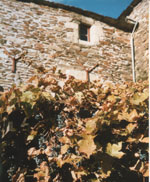
Clearly the best thing to do for me right now would be to get into
the car and drive a 1000km south to our regular place in France. The
weather should still be good enough to have lunch outside wearing only
a T-shirt, the colours of the leaves will be splendid and the grapes
'a point'. But then we all have resp. work to finish, schools
to attend and courses to teach so all of this will have to be delayed
just a little bit longer…
Some people are more fortunate.
According to her october column, Jeanette Winterson did spend most of
september in France and the daily routine she describes resembles ours
quite well. Mind you, there are differences. Whereas she goes for a
Kir I'll prefer a proper Pastis any time. She drinks the local
white wine, we go for the Rose (weather and supply permitting…)
from the Cave Cooperative 'La Cevenole' in
Rosieres. She only has to cycle 4 kilometers to get into
… a remote village enjoying two bakeries, a
butcher, a greengrocer, a fabulous deli, and a bar.
For us the nearest village having all of this on offer is Joyeuse and it takes 45 minutes by
car along narrow and winding roads to get there (1hr by bicycle to,
2hrs by bicycle back). The more important facts are similar though as
Jeanette Winterson describes in her september column :
Leave a CommentIt was a good day
to slow down, and now that I am here, I will find a different rhythm,
or rather, re-find the rhythm natural to me.Of course, what’s
important to me may not be important to you, different priorities are
fine, but I think we should make intelligent choices. The fact is that
a lot of what we do isn’t a choice at all, intelligent or stupid, we
just do it passively, and wonder where the day has gone.How
many days in a life?And when it’s gone, it’s gone.
I can hear a woodpecker tapping away like me. Maybe that
woodpecker is writing its memoirs. The woodpecker can hear me tapping
too. I am right by its tree, high up, in a top turret room. This
sympathetic Morse code makes me feel part of the life of the tree. It
is easier here to belong to other life forms, other ways of life. I am
aware of all the noises, the scents, the temperature. In the city, we
spend a lot of energy shutting life out – the noise, the aggression,
the crowded feel. It is such a relief to let life in, and even as I
write those words, I wonder how bonkers we are, making a life that is
anti-life; a life where life has to be shut out.